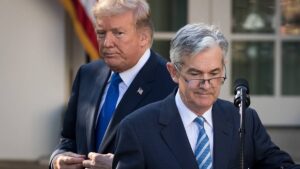Central bonkers: End of something is nigh as major monetary policy pursues its own interests

Via Getty
Like the end of the Gondwanaland, The Beatles the Spice Girls and one of the Two Bennifer’s, major Central Bank unity was never going to last forever.
This week the breaking up began.
Central banks ditched the same song sheet of the last 12 months and pursued their own diverging interest (rates).
The US Federal Reserve decided to take a pause in its long streak of rate hikes.
Last week, the RBA kept things at four to the floor.
Meanwhile, the worst central bank in Europe, the Bank of England (BoE) looks locked in for another rate rise by 25bps to a 15-year high of 4.75% when it meets next week, as analysts converge on the likelihood of a 13th consecutive volley against the stickiest inflation in 40 years.
Reuters says Brit investors this week bet on the BoE rates touching up to 6% this year – way, way beyond where the US Federal Reserve or the ECB are thought to be headed. That’d be a level not seen in Britain this millennium. (Though, it’s been a short one).
Breaking up is not hard to do
The sudden departures reflect the divergent economic challenges faced by us at home, by the EU, the US and China, but also the rapid response taken by The Fed vs The ECB.
The States hit the alarm and began raising rates in March last year, while the ECB adopted a wait and see approach to monetary tightening, which has them playing a little catch up.
“I don’t know who has more to do, but certainly the Fed has done more than the ECB,” Joseph Gagnon, a senior fellow at the Peterson Institute for International Economics (PIIE), told Agence France Press.
Which is why this week the European central bankers didn’t pause at all before agreeing to hoist again to the highest cash rate level in 22 years.
On the same planet, somehow, China’s central bank, cut its key rate.
The ECB
In a striking divergence from the already unhinged US Federal Reserve the European Central Bank (ECB) has hoisted interest rates to 3.5% overnight, a 22-year high and made the fiscal equivelant of a blood oath that it will increase them again in July.
The bank delivered another 25bps interest rate increase at its June meeting on Thursday – in line with market expectations – and as inflation looks plucky enough to ‘remain too high for too long.’
The official interest rate on main refinancing operations is now at 4% while the deposit facility increased to the 3.5% mark not seen since 2001.
And that’s because no one has ever hated inflation with more deadly venom than ECB president Christine Lagarde, the Lady Macbeth of Monetary Policy.
In another gothic rock star post-decision press conference, she thrilled at the opportunity of asking herself questions and then using her responses to scare the room into silence while making it abundantly clear the bank will not stop stabbing away at stubborn Euro inflation until, ‘safe in a ditch he bides, with twenty trenchèd gashes on his head, the least a death to nature,’ or similar.
Lagarde: We have revised our projection.
Lagarde: (nodding) We essentially did what we said we would do: data dependent and using the three elements of our reaction function to determine what was the right decision today.
Lagarde: (challenging the room into silence) That is the reason why we increased all three rates by 25 basis points.
Lagarde: Are we done? Have we finished the journey?
Lagarde: No, we’re not at destination.
Lagarde: Do we still have ground to cover?
Lagarde: Yes, we have ground to cover.
Lagarde: (cutting herself off) …I can even go further than that.
Lagarde: (interrupting) I can tell you that – bearing a material change to our baseline – it is very likely the case that we will continue to increase rates in July (stunned silence)…
Lagarde: (grins lasciviously) Which probably doesn’t come as a big surprise to you. But that’s what I’m telling you.
It’s a decisive contrast to what’s happening across the Atlantic where the US Federal Reserve chief and chair J. Powell declared a “pause” in its hiking cycle, leaving interest rates at 5% to 5.25% after more than a year of consecutive rate bumping.
The largely anticipated breather, conceived this week by the Fed’s Federal Open Market Committee (FOMC), marks a detour in the straight line officials have been traveling on inflation. With the situation still under the shadow of the 40-year high of 9.1% established back in June last year, the US is still struggling against a tide of rising food and energy prices.
The US Fed
US inflation however in May was down to 4%, the lowest since April 2021. Lagarde’s contempt for the idea of taking a moment to assess what previous rate hikes has done was also on display in Brussels:
I don’t know what difference to make between a pause and a skip. I have not studied enough the press conference of my friend and colleague, Mr Powell.
But as far as the ECB is concerned, I said what I said: we have hiked interest rates.
Unless there was a material change to our baseline, we will continue to hike at our next meeting. So, we are not thinking about pausing, as you can tell.
In the US, the FOMC expectedly left the fed funds rate unchanged at 5.125%. The accompanying statement was broadly the same as May, but the updated member forecasts showed greater confidence in the economy and uncertainty regarding inflation.
This followed the May CPI report which showed an 11th consecutive month of deceleration from June 2022’s 9.1%yr peak. Note though that annual CPI inflation is still twice the FOMC’s medium-term 2.0%yr target at 4%yr and core inflation is higher still at 5.3% yr, in large part due to shelter’s contribution.
The FOMC’s headline PCE inflation forecasts are unchanged from March at 3.2% yr, 2.5% yr and 2.1% yr 2023 through 2025; but the underlying strength of the economy saw core PCE inflation revised up 0.3ppts to 3.9% yr in 2023 and kept broadly unchanged at 2.6% yr and 2.2% yr for 2024 and 2025. That the end-2025 core PCE inflation forecast is above the 2.0% yr policy target is arguably as significant as the revision to 2023.
Consequently, FOMC members now project a year-end peak for the Fed funds rate in 2023 of 5.6%, 50bps higher than March. The end-2024 and 2025 forecasts are also 30bps higher than the prior set, respectively 4.6% and 3.4%. Versus the ‘longer-run’ estimate of 2.5%, this implies Committee members believe it will prove necessary to keep policy restrictive for more than 2.5 years from today.
On balance, the FOMC’s June decision leads us to believe one more 25bp hike in July is the most likely course – come early-2024 we expect the case to have been made for rate cuts.
The People’s Bank of China
China’s central bank – the People’s Bank of China (or the PBoC for what a fun acronym should look like) – surprised the galleries by lowering its seven-day reverse repurchase rate by 10 basis points (bps) to 1.9%.
The cut to the key short-term policy interest rate for Chinese lenders was the first slice and dice since August 2022. And probably overdue.
The initiative instantly adds circa 2 billion yuan (US$285 million) of liquidity into a thirsty financial system.
The bank said it was all about ensuring that “reliable and sufficient” liquidity levels were sloshing about in an economy which has distinctively underwhelmed.
China’s May data came in weaker, something of a downside surprise.
Fixed asset investment retreated to 4% yr YTD thanks to sluggish state-owned mega-projects and weakness in private investment.
With Foreign Direct Investment a real problem, policymakers will be reaching for the stimmy handbook, dependent as they are on growth to fuel extra capacity and some income expansion.
By cutting the 7-day reverse repo rate by 10 basis points, and followed up with a cut in the medium-term lending rate, the bank would also hope to entice consumers to open their wallets.
Both Chinese businesses and consumers, need additional encouragement, according to Capital Economics chief China economist Julian Evans-Pritchard.
On consumption, retail sales growth slowed in May to 12.7% yr from the 18.4% yr seen in April.
Services spending continues to outpace goods coming out of lockdown.
Industrial production was bleak for China’s standards, up 3.5% to 3.6% yr YTD.
Out of the 16 categories, 13 reported increases in year-to-date terms. The real highlight here, however was the massive increase in electric vehicle production. In EV land, China has quietly become king.
The Reserve Bank of Martin Pl.
The Commonweatlh Bank was the first major to act following last week’s RBA decision to raise the official cash rate.
CBA on Tuesday said it will lift interest rates across a swathe of its loan products, including lifting its home loan variable interest rates by 0.25% p.a.
Tuesday last, for a recap, at the June policy meeting the Reserve Bank of Australia (RBA) hiked the cash rate to 4.1%.
Our fired-up central bank again bumped up the cash rate by a fresh quarter-point to a new 11-year high, with Gov’ P. Lowe (PHD) warning us to expect further tightening vs inflation.
Lowe reiterated that inflation is still too high and in the post-match warm down omitted a key reference that says – “medium-term inflation expectations remain well anchored” – something which had been in policy statements since July last year and which has split forecasters for the next few meets.
Before that two more hikes locked a little locked and loaded at the July and August meetings.
Westpac, for one, thinks the hawkish tone was enough to envisage a cash rate to 4.60%.
“The first rate cut is also now expected to be delayed until May 2024, previously February 2024,” according to Westpac’s chief economist and Australia’s prime rates whisperer Bill Evans.
“The implications for growth and the labour market are material, with GDP growth of just 0.6% yr and 1.0% yr forecast for 2023 and 2024, and consequently the unemployment rate seen at 5.3% by end-2024.”
Related Topics
UNLOCK INSIGHTS
Discover the untold stories of emerging ASX stocks.
Daily news and expert analysis, it's free to subscribe.
By proceeding, you confirm you understand that we handle personal information in accordance with our Privacy Policy.








